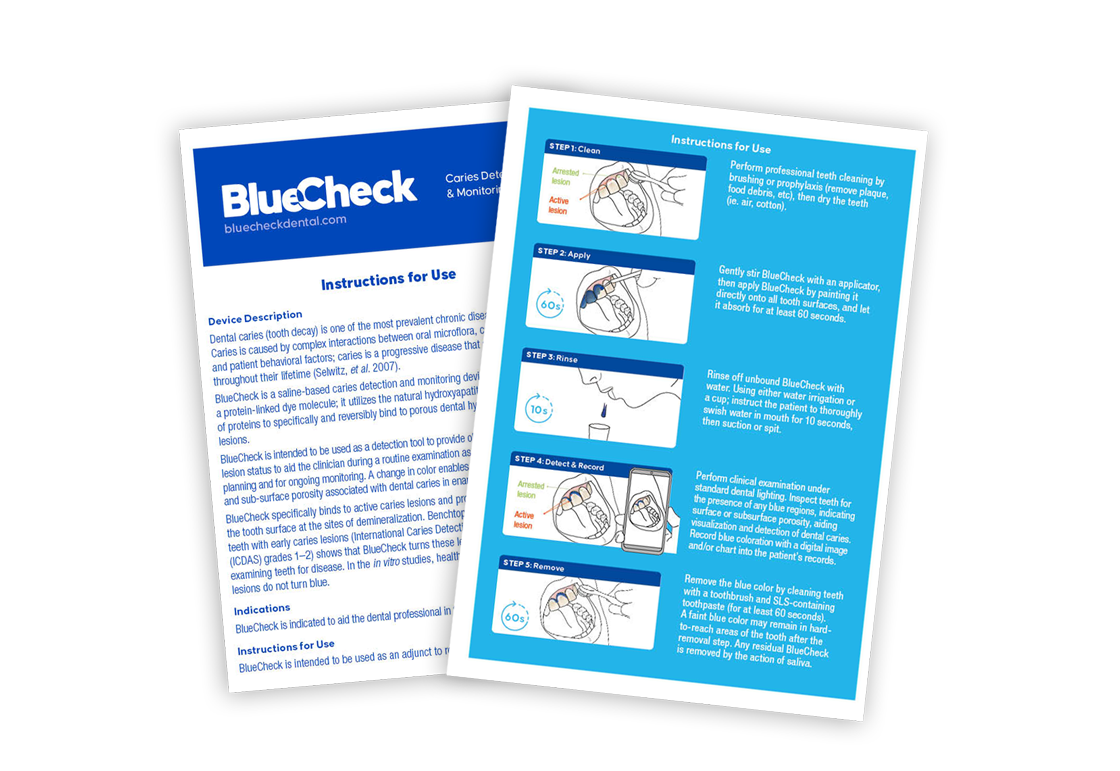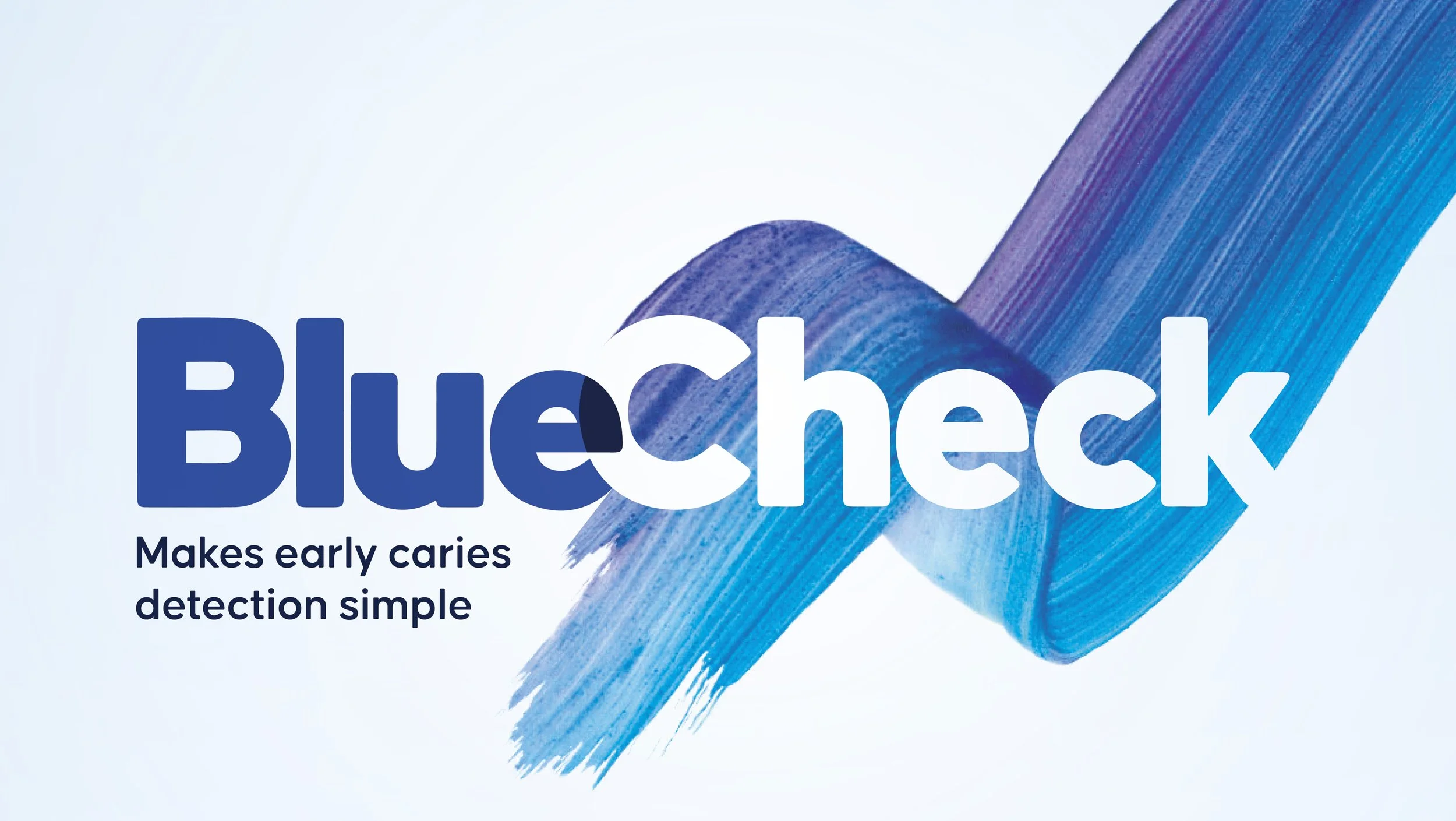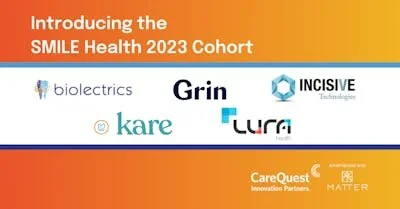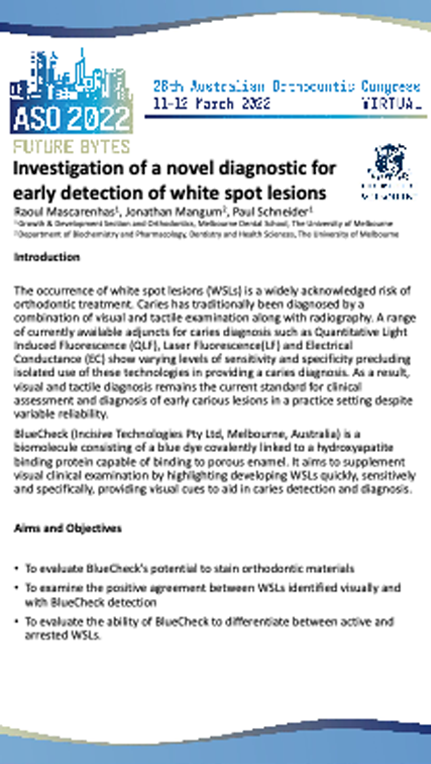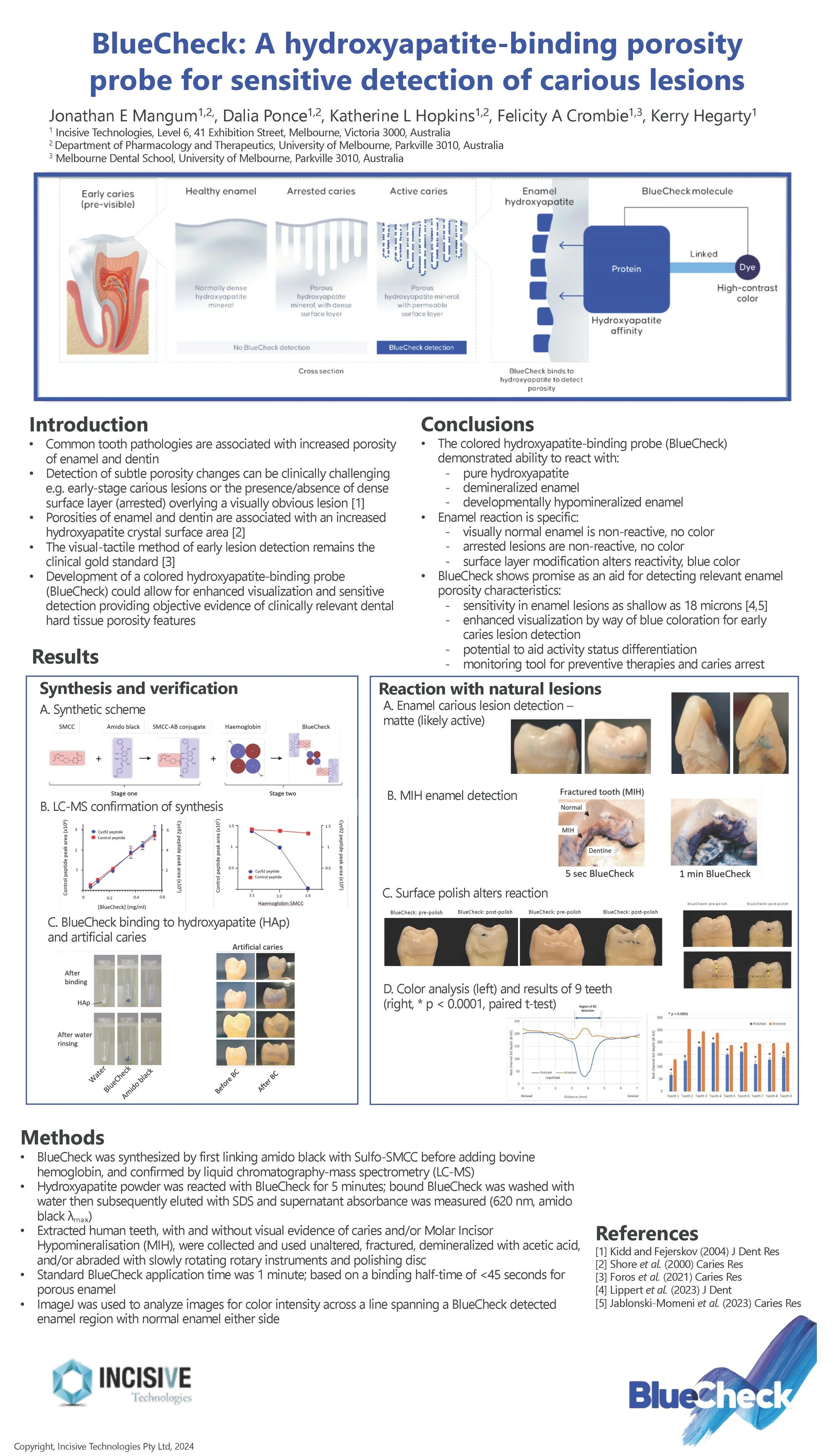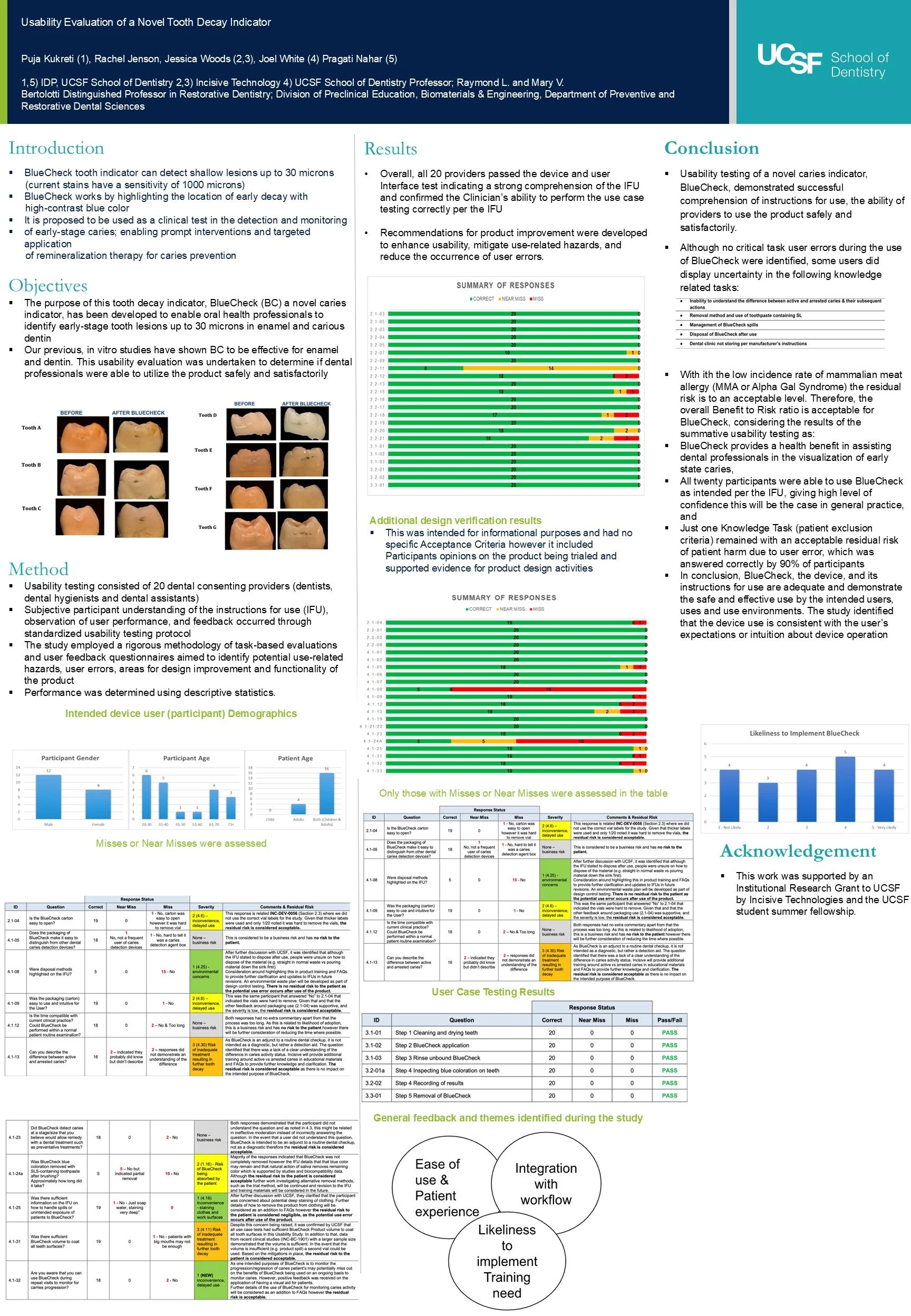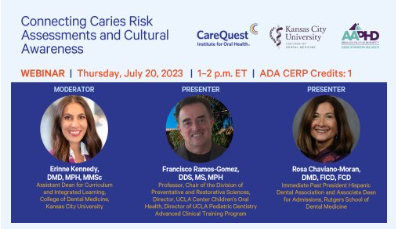How to use BlueCheck
Chairside guide
BlueCheck Guide for use chairside
BlueCheck Instructions for Use, IFU-B11040 REV: V3, 05/2023. 001865
Lippert F, et al. Detection of Artificial Enamel Caries-like Lesions with a Blue Hydroxyapatite-Binding Porosity Probe. J of Dent, 135, 2023.
Poster: Kukreti P, et al. Usability Evaluation of a Novel Tooth Decay Indicator. AADOCR, March 2025.
Instructions for use
FDA Approved Instructions for use
BlueCheck Instructions for Use, IFU-B11040 REV: V3, 05/2023. 001865
Selwitz RH et al. (2007) Dental Caries. The Lancet 369: 51-59.
Bluecheck in the News
Incisive Press Release
Incisive Technologies announces the US Food and Drug Administration (FDA) has issued 510K clearance for BlueCheck Caries Detection and Monitoring, a novel caries detection device used by clinicians in dental examinations to aid the detection of early caries (tooth decay).
Incisive Technologies’ BlueCheck receives FDA approval and is coming to the US dental market.
CareQuest Innovation Partners and Matter Announce Second Cohort for Smile Health and Extensive Roster of Industry-Leading Partners.
Publications
Poster: Jablonski-Momeni A, et al. In-vitro performance of BlueCheck liquid as a novel technology for detection of initial enamel demineralization. ORCA, July 2022.
Poster: Lippert F, et al. Investigating the ability of a blue dye to selectively stain early enamel caries lesions. ORCA, July 2022.
Poster: Mascarenhas R, et al. Investigation of a novel diagnostic for early detection of white spot lesions. ASO, March 2022.
Poster: Jablonski-Momeni A, et al. In-vitro performance of BlueCheck liquid for detection of initial lesions on occlusal surfaces. ORCA, July 2023.
Poster: Mangum J, et al. BlueCheck: A hydroxyapatite-binding porosity probe for sensitive detection of carious lesions. IADR, March 2024.
Poster: A. Jablonski-Momeni, et al. A new early caries detection aid (BlueCheck) does not inhibit remineralisation of artificial enamel caries. ORCA, June 2024.
MedTech Market Growth Program 2024
Incisive Technologies selected recipient for MedTech Market Growth Program Grant from LaunchVic and Department of Jobs, Skills, Industry and Regions.
Australian Government Industry Growth Program Grant Recipient 2024
Incisive Technologies selected recipient for Australian Government’s prestigious Industry Growth Program Commercialisation and Growth Grant.
Poster: Kukreti P, et al. Usability Evaluation of a Novel Tooth Decay Indicator. AADOCR, March 2025.
Frequently Asked Questions
-
BlueCheck is a paint-on application, taking less than a few minutes, used as a professional chairside detection aid to identify dental caries in enamel and dentin. It is designed to objectively visualize early stage decay.
-
BlueCheck is a saline‐based caries detection and monitoring device, a solution containing a novel biomolecule (a protein‐linked dye).
When applied by painting onto a patient’s teeth, BlueCheck absorbs into the dental tissue where it specifically and reversibly binds to regions of porosity. After a rinse step, unbound blue is washed away with water, leaving a visible blue color on the tooth’s surface at the sites of demineralization.
BlueCheck utilizes the natural hydroxyapatite‐binding chemistry of proteins to bind to the dental hydroxyapatite in active caries lesions. A change in color enables clinicians to visualize surface and sub‐surface porosity associated with dental caries in enamel and dentin.
There is no blue color where there is an intact enamel surface (healthy enamel) or an arrested surface layer (arrested or healed lesion) where there is no exposed hydroxyapatite crystal for BlueCheck to bind to.
-
Indications: BlueCheck is indicated to aid the dental professional in the visualization of carious lesions.
Instructions for Use: BlueCheck is intended to be used as an adjunct to routine clinical dental examinations.
-
BlueCheck’s procedure is simple and it gives a fast, direct, sensitive and specific measure of disease status.
It was designed as a prevention tool to aid Clinician in the management of their patient’s by aiding the detection and prevention of dental caries. It enables the visualization of early-stage (incipient / enamel) active caries lesions.
Early detection of disease enables the use of non-invasive treatment options to repair and heal the tooth’s enamel.
-
Store at Room Temperature 2° to 25°C (35° to 77°F).
Avoid direct heat or sunlight and do not freeze.
-
BlueCheck has no added flavour and has a neutral, slightly salty taste.
-
Instructions For Use, Precautions:
Do not use on patients with allergies or sensitivity to the ingredients of BlueCheck.
Use on patients with clinically severe developmental dental defects with exposed subsurface tooth enamel and dentine (such as amelogenesis imperfecta), may lead to coloration due to the developmentally porous tissue.
-
No the blue color is not permanent.
BlueCheck’s hydroxyapatite binding uses a temporary electrostatic interaction, and the blue is easily removed with SLS-containing toothpaste and/or a Hydrogen Peroxide Solution (3%).
Internal Studies under a worst case scenario have shown that any blue color on teeth is removed by action of saliva within 6 hours.
-
Unlike other caries or plaque detection devices, if BlueCheck has colored a patient’s lips and gums during application, the color is removed by rinsing with water and/or the use of SLS-containing toothpaste.
-
If spills do occur, immediate washing with soap and water will reduce the extent of any staining. For spills on surfaces, use absorbent paper or cloth to collect the material, then wash with soap and water.
-
BlueCheck is non-toxic to the environment, is not a biohazard and its packaging is recyclable.
It can be disposed of in the normal trash waste bins, per local recycling and disposal guidance. To avoid spills and unintended coloration, ensure the lid is securely fastened to the vial prior to discarding.
External Resources: Prevention and Minimally Invasive Dentistry
External Guidance
The Non-Invasive Caries Therapy Guide
The CareQuest Non-Invasive Caries Therapy Guide is an illustrated manual on diagnostics, preventives, and therapeutics to fight dental caries without removing tooth structure, including instructions and tips to manage dental caries.
CareQuest Institute for Oral Health. The Non-Invasive Caries Therapy Guide. Boston, MA: April 2023.
Updating Your Knowledge of Dental Caries: Causes, Concerns, and Considerations
The CareQuest Updating Your Knowledge of Dental Caries: Causes, Concerns and Considerations is a webinar that explores What causes dental caries? And how can a greater understanding of the disease help providers offer preventive, person-centered care that leads to better overall health?
In this webinar, a collaboration between CareQuest Institute, Kansas City University, and the American Association of Public Health Dentistry (AAPHD), our expert panel will take a deep dive into the etiology of dental caries, including the role of host factors, saliva, diet, and oral hygiene. They will also cover the epidemiology of caries, the contributory causes of the disease, and the concept of the caries balance.
This is the first in a series of summer webinars on understanding, assessing, and managing caries.
CareQuest Institute for Oral Health. Webinar: Updating Your Knowledge of Dental Caries: Causes, Concerns and Considerations. June 2023.
Self Paced Education Online Course (1 CE)
Connecting Caries Risk Assessments and Cultural Awareness
The CareQuest Connecting Caries Risk Assessments and Cultural Awareness is a webinar that covers assessing a patient’s risk for caries is a key component of preventive care that is critical to a patient’s overall health and well-being. Which assessment method is most effective? And how do you communicate risks in a way patients understand?
In this webinar, a collaboration between CareQuest Institute, Kansas City University, and the American Association of Public Health Dentistry (AAPHD), our expert panelists will discuss the CAMBRA — caries management by risk assessment — system and its benefits. They’ll also explore the role of coaching, motivational interviewing, and cultural humility to help identify and address patient risk factors — especially those outside of the dental office.
This is the second in a series of summer webinars on understanding, assessing, and managing caries.
CareQuest Institute for Oral Health. Webinar: Connecting Caries Risk Assessments and Cultural Awareness. Boston, MA: July 2023.
Self Paced Education Online Course (1 CE)
Managing Dental Caries: Evolving Strategies and Proven Techniques
The CareQuest Managing Dental Caries: Evolving Strategies and Proven Techniques is a webinar that explores new evidence, new treatments, and new innovations shape the way dental teams manage the disease. As what we know about cariology continues to evolve.
How can providers apply this knowledge to provide personalized prevention recommendations for patients?
In this webinar, a collaboration between CareQuest Institute, Kansas City University, and the American Association of Public Health Dentistry (AAPHD), our expert panel will explore that question and various strategies for managing dental caries. They will also talk about avoiding a “one-size-fits-all” approach, sharing guidance on nonsurgical and nonrestorative protocols and implementation.
This is the third in a series of summer webinars on understanding, assessing, and managing caries.
CareQuest Institute for Oral Health. Webinar: Managing Dental Caries: Evolving Strategies and Proven Techniques. Boston, MA: August 2023.
Self Paced Education Online Course (1 CE)
Innovative Pediatric Dental Care: Exploring Minimally Invasive Procedures
Minimally invasive dentistry prioritizes the preservation of healthy tooth structure while utilizing techniques to manage caries and prevent disease progression. How can this approach be effectively applied in pediatric dentistry to benefit young patients?
Join CareQuest Institute and the American Association of Public Health Dentistry for a webinar that will explore evidence-based, minimally invasive dental procedures tailored for children and adolescents. Our expert panel of pediatric dentists will discuss the advantages of these procedures and provide guidance on integrating them into daily practice. They'll also share insights on cariology, silver diamine fluoride (SDF), glass ionomer applications, Hall crowns, and effective communication strategies for children and their families — all designed to improve oral health outcomes for young patients.
Explain the principles of minimally invasive dentistry, including tooth remineralization and preservation.
Identify the key elements of the caries disease process and recognize how risk assessments guide patient-centric care decisions.
Discuss the benefits of several treatments as they relate to caries management, including silver diamine fluoride (SDF), glass ionomer materials, atraumatic restorative treatment (ART), and Hall crowns.
CareQuest Institute for Oral Health. Webinar: Innovative Pediatric Dental Care: Exploring Minimally Invasive Procedures. Boston, MA: October 2024.
Self Paced Education Online Course (1 CE)
Emerging Approaches in Oral Health Care: Considerations for Minimally Invasive Care
Takeaways
Minimally invasive care (MIC) is an approach in dentistry that prioritizes dental caries (tooth decay) risk assessment and prevention, early dental caries detection and restoration, and the preservation of tooth structure in dental caries treatment.
By supporting and prioritizing MIC, state Medicaid agencies can help: (1) increase access to oral health care in non-traditional settings; (2) advance health equity; (3) expand the oral health care workforce; and (4) integrate oral health care services into physical health care.
This brief also describes opportunities for state Medicaid programs to support the availability of MIC through payment strategies that encourage the uptake of these services.
Center for Health Care Strategies. January 2024.
Access The Brief
Best Practice Approach: Early Childhood Caries: Prevention and Management
A Best Practice Approach Report describes a public health strategy, assesses the strength of evidence for the effectiveness of the strategy, and uses practice examples to illustrate successful/innovative implementation.
Association of State and Territorial Dental Directors (ASTDD) Best Practices Committee. Best Practice Approach: Early Childhood Caries Prevention and Management [monograph on the Internet]. Reno, NV: Association of State and Territorial Dental Directors; Washington, DC: National Maternal and Child Oral Health Resource Center; 2023. Available from: www.astdd.org.
Evidence-based clinical practice guideline on nonrestorative treatments for carious lesions
An expert panel convened by the American Dental Association Council on Scientific Affairs and the Center for Evidence-Based Dentistry conducted a systematic review and formulated evidence-based clinical recommendations for the arrest or reversal of noncavitated and cavitated dental caries using nonrestorative treatments in children and adults.
JADA. A Report from the American Dental Association: October 2018.
WHO notes oral diseases affect close to 3.5 billion people worldwide
The WHO Oral Health Programme leads the work on setting the global oral health policy agenda in close collaboration with member states and other key stakeholders. Recent momentum has led to the development of key policy documents to support countries in moving towards universal health coverage for oral health by 2030.
WHO A Global Health and Action Plan on Oral Health: Geneva: World Health Organization; 2024. Licence: CC BY-NC-SA 3.0 IGO. May 2024.
WHO SDF and dental carries
WHO Glass Ionomers and dental carries

